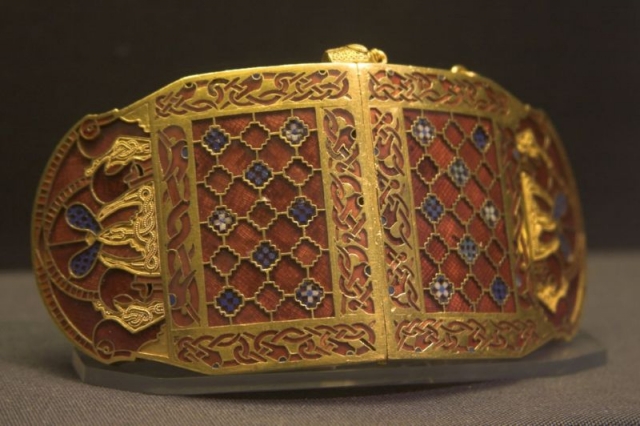Visual image exemplar: Using pictures of Sutton Hoo objects
Exemplar

Please note: this lesson was produced as part of the Nuffield Primary History project (1991-2009) and pre-dates the 2014 National Curriculum.
The Sutton Hoo ship burial contained a king's ransom in gold and jewellery. Indeed, it contained the worldly and spiritual goods needed for the king's voyage into the next world.
But all I had as resources, from the British Museum shop, were little postcards of four of the Sutton Hoo treasures: the belt buckle, the helmet, the shoulder straps, and the purse lid. I had two postcards of each object, making eight in all. With so few pictures, I had to think hard about the teaching and about the questions which are at the heart of the matter. [See the link to the British Museum website on the right for Sutton Hoo pictures.]
Setting the scene
I began the session by telling the class the story of the discovery of Sutton Hoo: the worried archaeologist on his bike; the four top men in the business excavating away like fury against the clock pointing towards September 1939; the packing of the finds in wet moss to be watered throughout the war; and of Mrs Pretty's generosity in presenting the treasure to the nation.
By this stage the children were fascinated and desperate to see some of the treasure. So we started by focusing on the 32 cm-long belt buckle. The children automatically began measuring it with their hands in the air - huge! It weighed 412 grams. We weighed out the equivalent in paper and held the pile reverentially. We thought of the thousands of pounds worth of gold it represented. What could we buy with that - a car, perhaps?
Examining the pictures
We divided the class into eight groups and gave each group a postcard. We asked them to examine the picture of their find with care and to write down the skills needed by the people who had made the object. Soon we had a long list of skills:
Moulding
Mixing colours
Using strength
Measuring accurately
Working in glass
Making chains
Mining metals
Working with metals
Intricate, detailed work
Using gold
Using fine tools for cutting
Bending wood
Weaving patterns
Making nails
We looked back over the list and asked whether the children could now tell us something about the wealth and power of these people. They could indeed, and generated another long list of ideas.
Finally we asked the children to consider what made people bury such treasures in the ground. The range of thought about the burial of treasure was astonishing:
' For a journey
' Out of pride - their king should appear good when he got to heaven
' They might have feared the return of the king, either as a ghost or re-incarnated, to punish them for keeping his things
' Out of respect for a great man.
There were many more ideas: these 11-year-old children had questioned just four pictorial sources, but were beginning to think like archaeologists and historians.
(John Fines from Teaching Primary History, now out of print)

